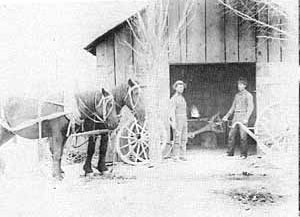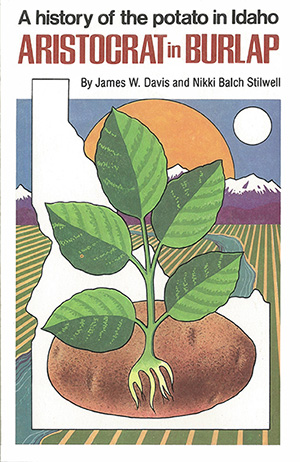 Early settlers relied on the blacksmith to keep horses shod.
Early settlers relied on the blacksmith to keep horses shod.
"A bushel of potatoes weighs 60 pounds," the newspaper states, "and by this process (evaporation) it can be condensed to 13 pounds at an expense of about nine cents per bushel. At present, it costs two cents per pound to haul a bushel of potatoes from Boise City to Hailey, a distance of 144 miles. This is $1.20 per bushel. But if you evaporate the water and condense your bushel of potatoes into 13 pounds of bulk, your freight is but 26 cents or a clear savings of 85 cents upon your bushel of potatoes."
Z.C.M.I. had connections in the Mormon settlements of Southern Idaho. One assumes that Idaho settlements must have supplied part of the potatoes for export. The Utah Northern Railroad, which connected Franklin with Salt Lake City, provided good connections.
An article in the Deseret News of February 3, 1888, indicates that Utah (and presumably Idaho, as well) had, prior to that time, shipped some potatoes to the Eastern market, probably by way of Chicago.
The spread of potato agriculture in Eastern Idaho was only a matter of time. Henry E. Jenkins was a freighter, hauling cargo from Lorrine, Utah, to Virginia, Montana, with teams of oxen in 1870. As reported by his daughter, Mrs. John A. Rassmussen of Idaho Falls, in the spring of that year, Jenkins hauled a load of potatoes from Farmington, Utah, to Blackfoot, Idaho. The recipient of the shipment was Judge Stephens, who was encouraged by the freighter to plant the potatoes believed to be the first planting in the Blackfoot area. At that time, Idaho Falls was known as Eagle Rock, and a man named John Anderson had built a toll bridge across the Snake River, which was utilized by Jenkins in his freighting operation.
Jenkins was apparently on hand in the fall when the potatoes were harvested and reported that they were "as hard as rocks." In spite of this apparent lack of quality in the first crop planted in the Blackfoot area, it did not discourage the early farmers as additional plantings were made in the vicinity. More and more potatoes were planted, and the Blackfoot area has grown now into one of the principal potato producing areas in Idaho.


 Early settlers relied on the blacksmith to keep horses shod.
Early settlers relied on the blacksmith to keep horses shod.